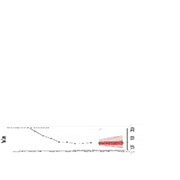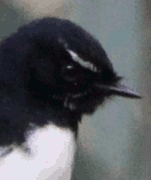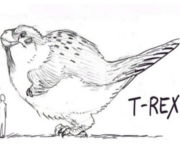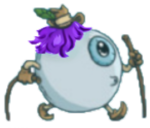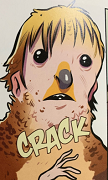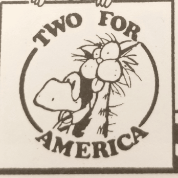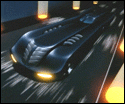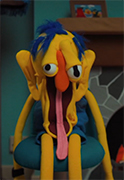|
Non Compos Mentis posted:its a shame we dont know what colour an extinct animal was We know for some! There have been a lot of developments in this area in recent years. Microraptor was coloured like a modern crow and Sinosauropteryx was coloured like a raccoon or red panda.
|
|
|
|

|
| # ? May 6, 2024 16:52 |
|
Peanut Butter posted:Microraptor was coloured like a modern crow https://www.youtube.com/watch?v=tvMrACaQjlw
|
|
|
|
like hamburger
|
|
|
|
Amazing stuff, super informative. Thank you!
|
|
|
|
Yo big thanks for the effortposts. It's really cool that people choose to spend their time on this gay Earth writing really intricate posts for me to read on this dying forum.
|
|
|
|
aminals
|
|
|
|
Grass evolved ~200 million years after dimetrodon.
|
|
|
|
|
Funny how cetaceans struggled to expand into warm water and then Afrotheria comes along like "Imma eat some plants and float around"
Jimbone Tallshanks fucked around with this message at 00:04 on Apr 24, 2024 |
|
|
|
your post led to a wikipedia rabbit hole which led to this excellently-titled picture:
|
|
|
|
Jimbone Tallshanks posted:Funny how cetaceans struggled to expand into warm water and then Afrotheria comes along like "Imma eat some plants and float around" Quite literally that really was the Sirenian hack, unlike fish seagrass is hopefully not going to outrun you no matter how much the ambient water temperature boosts their metabolism. Its really interesting how much different groups can be affected by things like ocean temperature and food preferences, another obvious example are sea snakes, who basically have the opposite distribution of pinnipeds and do really, really well as cold blooded animals in the warm shallow seas of Indonesia and Oceania, as you can see in the map below (only one species, the yellow bellied sea snake, finds its way over to American side of the Pacific, all of the other 70+ live in Eastern half of the Pacific and the Indian ocean, with the vast majority of species living in the waters of the Malay archipelago). They are especially suited to coral reefs where their body shape gives them great ability to weave in and out of the crevices. A number of species have even evolved weirdly disproportionately small heads to facilitate this and let them chase prey into the tinniest of cracks.  
khwarezm fucked around with this message at 01:09 on Apr 24, 2024 |
|
|
|
what does the intermediary between a hooved mammal and a whale look like?
|
|
|
|
Peanut Butter posted:We know for some! There have been a lot of developments in this area in recent years. Microraptor was coloured like a modern crow and Sinosauropteryx was coloured like a raccoon or red panda. What manner of sorcery is this?
|
|
|
|
Mozi posted:what does the intermediary between a hooved mammal and a whale look like? ur mom  just a big rat I guess
|
|
|
Mozi posted:what does the intermediary between a hooved mammal and a whale look like? Hippos.
|
|
|
|
|
Mozi posted:what does the intermediary between a hooved mammal and a whale look like? Probably different than you'd think because the hoofed mammals they came from looked like rats, weasels, or maybe Tasmanian wolves. 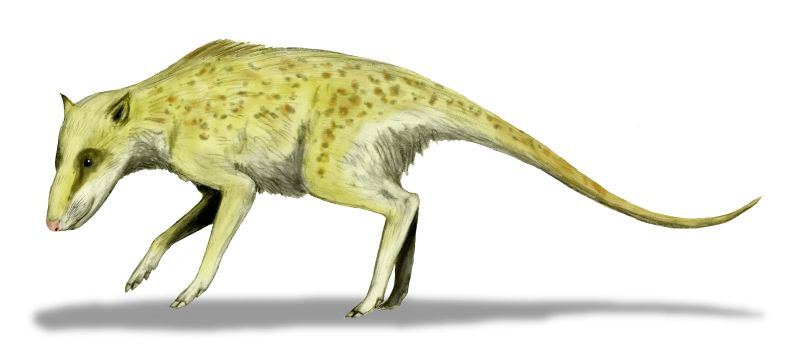 So the intermediaries look more like furry alligators to me than some kind of swimming pig or goat. 
|
|
|
|
Big mousey
|
|
|
|
Jimbone Tallshanks posted:So the intermediaries look more like furry alligators to me than some kind of swimming pig or goat. OK now I can see it, thanks.
|
|
|
|
I'm trying to picture what a modern whale would look like with thick luxurious fur like an otter. It would probably get all mossy and be it's own little ecosystem. I googled furry whale but that was a mistake.
|
|
|
|
Mozi posted:OK now I can see it, thanks. Here's a helpful video https://www.youtube.com/watch?v=oaxNhgVVYh4
|
|
|
|
There's an online paleo lecture convention on Discord/Twitch this Saturday if that floats anyone's paleoboat https://www.youtube.com/watch?v=HC_iMC8EdA0 
|
|
|
|
Sorry, the chomp-whale has made me afraid to board the paleo boat.
|
|
|
|
How to Skin Your Diplodocid: tips and tricks for the aspiring palaeotaxidermist. Alternative post: from the author of How to Train Your Dragon comes an exciting new story...
|
|
|
|
https://youtube.com/shorts/UTr8sKGQXyE?si=eIuRddDi6xaWIMDq THAT WE KNOW OF
|
|
|
|
khwarezm posted:Quite literally that really was the Sirenian hack, unlike fish seagrass is hopefully not going to outrun you no matter how much the ambient water temperature boosts their metabolism. Its really interesting how much different groups can be affected by things like ocean temperature and food preferences, another obvious example are sea snakes, who basically have the opposite distribution of pinnipeds and do really, really well as cold blooded animals in the warm shallow seas of Indonesia and Oceania, as you can see in the map below (only one species, the yellow bellied sea snake, finds its way over to American side of the Pacific, all of the other 70+ live in Eastern half of the Pacific and the Indian ocean, with the vast majority of species living in the waters of the Malay archipelago). They are especially suited to coral reefs where their body shape gives them great ability to weave in and out of the crevices. A number of species have even evolved weirdly disproportionately small heads to facilitate this and let them chase prey into the tinniest of cracks.
|
|
|
|
God I love extinct beasties. Some of my favorites are the scansoriopterygid dinosaurs, tiny little theropods who evolved to scamper around in trees and hunt bugs. At least two of them, Yi qi and Ambopteryx longibrachium, developed bizarre membranous bat-wings that didn't let them fly but helped them glide around like flying squirrels.
|
|
|
|
Chicken Thumbs posted:God I love extinct beasties. Some of my favorites are the scansoriopterygid dinosaurs, tiny little theropods who evolved to scamper around in trees and hunt bugs. At least two of them, Yi qi and Ambopteryx longibrachium, developed bizarre membranous bat-wings that didn't let them fly but helped them glide around like flying squirrels. I did not know arboreal theropods existed…we coulda had griffins for real…
|
|
|
|
Anyone else going to the North American Paleontological Convention this year? NAPC Goonmeet
|
|
|
Peanut Butter posted:I absolutely love your effortposts, please keep making them! It's rare to find text-based lay information for adults on paleontological topics, especially for non-Mesozoic (and realistically, non-Cretaceous) fauna. Paleontologist Darren Naish's blog Tetrapod Zoology has been mentioned upthread once or twice, along with his podcast and book All Yesterdays. He was also the chief scientific consultant for the Apple TV series Prehistoric Planet. He is, imo, really good at conveying zoology in an approachable way without dumbing it down. Most of his professional work is on English theropods (esp. Nanotyrannus) and marine reptiles, but he covers a wide range of living and extinct animals on the blog. The comments are full of other scientists, so it's also not a bad place to find links out to more stuff.
|
|
|
|
|
Thanks for posting this because I'm going to springboard off of it to rave about how the Triassic Period is incredibly interesting and make a series of effortposts all about it.   So, here's the thing, your average member of the public might be aware that dinosaurs come from three periods in Earth's history, the Triassic, Jurassic and Cretaceous. Leaving aside the fact that birds are just Maniraptoran theropods so dinosaurs are still one of the most important parts of earth's biosphere today, this is fairly neat since it marks out the Mesozoic period, after the Palaeozoic and before the Cenozoic, basically best understood by most people as 'that time dinosaurs ruled the earth', running from 251 million years ago to 66 million years ago, a very significant chunk of the Phanerozoic eon when life really dominated the earth's surface. Now, at the risk of sounding a bit elitist, for your average dino fan who is recalling their DK dinosaur books from 1998 or whatever was in the last Jurassic World movie most of the attention is given to the Cretaceous, since all of the famous dinosaurs like T-Rex, Triceratops and Velociraptor are from then, and the Jurassic, mostly because it lends its title to the most popular dinosaur related franchise and maybe people remember that Allosaurus, Stegosaurus and all of the Sauropods are from then (I'd like to think people don't still have a misconception that Sauropods just died out during the Cretaceous but I'd say that will take a long time to change). The Triassic mostly just comes up purely as the origin story of Dinosaurs but nothing beyond that, you're lucky if people can remember a single species of Triassic dinosaur and usually it will be either Coelophysis or Plateosaurus. But, the true prehistoric life enjoyer knows that this is a completely misplaced perspective on the Triassic, in reality the Triassic is one of the most bizarre and incredible eras in the entirety of Earth's history and the collection of life was like nothing seen before and after, boiling it down to the prologue of the dinosaurs misses all of the weird and wonderful stuff going on outside of that, and even the dinosaur story itself has a lot more complexity than people realize. Within 50 million years the amount of major developments in this time period is dizzying, its bookended by two mass extinctions, starting with the most apocalyptic event in the last billion years of Earth's history that completely reshaped all life on Earth in its wake. This mass extinction was so large that a lot of people perceive that the recovery of life coming out of it was so explosive they sometimes call it the 'Triassic Explosion', drawing an obvious parallel with the Cambrian explosion, basically a zillion different lifestyles and absolutely bizarre adaptations and body plans were being tried out by everything since so many niches were available and so many ecosystems turned upside down, to touch on a few things, this was the period with the first flying tetrapods (Pterosaurs), the first Mammals, the first Dinosaurs, the first Crocodylomorphs, the first Turtles, the first Modern Amphibians (Lissamphibians), the first modern reptiles (Lepidosaurs, entailing modern Squamates and Rhynchocephalians) the first Teleost fish (which account for 95% of all living fish species), the first truly giant animals in both land and sea (including as mentioned above, a potentially blue whale sized Ichthyosaur) and an absolute cavalcade of new Marine reptiles as basically everyone and their mother piled back into the ocean after having left it more than 100 million years previously. In all of this wacky new concepts and experiments in life came and went, different groups of animals could rise and fall in very short periods of time, the pure weirdness of Triassic life has become such a meme in the Paleo community online that you get Tumblr blogs and Youtube channels playing into the idea, I'm going to just post a video from Eons here trying to explain just what the hell was going on: https://www.youtube.com/watch?v=moxu_uTemNg Trying to cover an entire period like this and hit the major notes worldwide is far beyond the scope of one post, so I'll probably divide this into about four, including one completely dedicated to the insanity that was the Triassic seas. This first post will mostly cover the early Triassic, although the official subdivisions of the Triassic are, predictably, very strange and confusing with 'Early' Triassic only being about 5 million years while 'Late' Triassic covers the majority of the whole period, more than 35 million years, so I'm not going to consider myself particularly beholden to the official breakdown of the period.  The absolute most important aspect of the early Triassic, starting about 251 million years ago, was the fact that the world was coming out of the wake of the largest mass extinction of the entire history of the earth. The utterly apocalyptic Permian-Triassic extinction was the closest Earth ever came to just exterminating complex life altogether, its a titanic event that absolutely deserves much larger coverage in the future, especially if I do a Permian series of some sort, but for now I'll try and hit the major notes. Basically it seems that an absolutely massive Flood-Basalt eruption in an igneous province known as the Siberian Traps turned a significant chunk of the planet into Mordor with lava flows covering millions of square kilometres. In addition to the immediate destruction of the earth vomiting out huge amounts of molten rock across an area roughly the size of Australia, the release of huge amounts of carbon dioxide and other dangerous gasses wrecked absolute havoc on the Earth's climate, in large part because the magma encountered big deposits of organic deposits like coal and burnt them up. Massive scale global warming occurred with the Earth's temperature rising by upwards of 8 °C in few hundred thousand years. On land this resulted in most of the earth turning into a barren desert with just about everything dying in droves, 70% of land vertebrate species died out and even the insects, usually the group of animals who withstand major extinction events the best, were hit hard, with a number of major groups like Palaeodictyopteroids being wiped out entirely, plants, also a group that usually makes it through mass extinctions without much bother, also took severe losses with previously successful members like Glossopteris going extinct, though it has been argued that the effects on plants overall were less bad than previously assumed. As bad as things were on land in the seas it was even worse, something like 90% of marine species of all groups were killed off. Initially the volcanic activity mostly didn't effect marine life compared to terrestrial, but with the ongoing volcanic activity the intense global warming made large parts of the ocean fundamentally unliveable, near the equator the ambient ocean temperature might have cracked 40 degrees Celsius. The high temperatures and huge amount of CO2 meant that marine life was hit with a particularly intense double whammy that marks most great disasters in evolutionary history of the seas, an anoxic event choking the oceans of Oxygen since warm water carries less oxygen and there was a huge bloom of micro-organism pulling oxygen out of the water, and an acidification event, driven by the high atmospheric CO2 levels that literally dissolved the hard body parts of most animals that had them, including Bivalves, Brachiopods, Crustaceans, Fish, Gastropods, Corals, Echinoderms and Cephalopods. There might have even been a breakdown in the Earth's ozone layer, letting in dangerous ultra-violet rays just to add insult to injury.    The major casualties of this extinction were numerous, but to cover some important ones, Trilobites and Eurypterids, that had long been in decline, were completely eradicated, ending these groups that had previously been dominant lifeforms for millions of years forever. Therapsids, which had been the main groups of dominant land animals of the Permian, were absolutely wrecked, with several important groups like the Gorgonopsids killed off entirely, and another major group, the Dinocephalians, having been killed off a few million years earlier in an early pulse of the Permian mass extinction (some people consider this, the Capitanian mass extinction, to be a separate extinction event, but it was so close to the main one that its hard to disentangle them). Parareptiles, another major part of the Permian's biota, were also decimated, with the big herbivorous Pareiasaurs wiped out entirely and the remains just being a group of small, lizard like animals called Procolophonids. In the seas, Brachiopods, Crinoids, Ammonites, Holocephalans and Gastropods took very, very heavy losses but weren't exterminated. The longer term effects of the extinction on marine environments will be explored in the future, but broadly I'll just say that for both land and sea, it would take almost 10 million years for life to recover to 'normal' amounts of diversity that ecosystems would have had prior to the horrors of the late Permian.     The landscape of the Earth at the start of the Triassic was mostly just carrying over from the Permian, most notably Pangaea had formed at the end of Carboniferous and was still well intact, with the super-continent mostly centered in the Southern hemisphere forming a C shape that enclosed the Tethys Ocean, with the Panthalassa covering the rest of the planet. There were continental shards of what is now China that were a bit detached from the rest of Pangaea that helped define the eastern boundaries of the Tethys, and generally the chunk of Pangaea that had modern day Siberia and Eastern Europe was a little bit more detached from the rest, though still touching it. Famously, the fact that almost all of the land was clumped together contributed to a homogenization of Terrestrial life, since animals could range across huge areas unimpeded by ocean barriers you saw a lot less weird isolated diversification that made places like Cenozoic Australia and South America so odd compared to the rest of the world as I covered in my previous posts about them. Not to say everything was uniform when there were still large climatic and geological barriers like deserts and mountains in the way for various creatures, but its certainly clear that you could find similar animal types spread over a vast area. Some scientists think that the existence of Pangaea helped exacerbate the extinctions during the Permian, since it squeezed out a lot of shallow seas and made the environment more extreme and harsh, certainly the fact that that the land was connected into such vast areas seems to have caused a lot of climatic difficulties in many regions. The deep interior of Pangaea seems to have been marked by gigantic deserts since rainwater from oceans couldn't penetrate deep enough into the continental mass. Combined with the very high overall temperature of the earth it might have been the case that temperatures during summer near the equator in these deserts could reach 60 degrees Celsius. Even in wetter places, the climate seems to have been dominated by extreme seasonality, with it being theorized that the nature of Pangaea facilitated 'mega-monsoons' with most of the rainfall happening in torrential downpours crammed into the colder months of the year with next to no rain the rest of the year. The early Triassic, coming right out of a time period marked by a mass extinction caused by extreme Climate Change, was also probably the hottest that the global climate has been through the entire phanerozoic (the last half billion years), and possibly well beyond that.   In the aftermath of the Permian extinction the animal life that made it through on land in the early Triassic were still broadly within the same groups that dominated during the Permian, despite the extreme losses. During the Permian the most dominant group of animals were Synapsids. Synapsids as a clade actually include mammals, and thus us, in older works you often see groups like Dinocephalians and Gorgonopsids somewhat lazily called 'Mammal like reptiles' but this isn't really in fashion anymore in part due to the fact that 'Reptile' tends to be rather poorly defined and when it is it usually ends up excluding Synapsids, but also because recent research tends to point towards these animals being more like mammals than they would be like what we call reptiles. Synapsids go waaaaay back, all the way to the late Carboniferous period when they split from other Amniotes, usually they are recognised as Synapsids by the presence of a hole in the skull, a temporal fenestra which is still present in humans, compared to Diapsids (entailing all reptiles and birds) which possess two such holes. In addition to that, from an early stage Synapsids also began differentiating their teeth, particularly with the distinction of Canine teeth from the rest in the jaw, and consolidating their lower jaw into a single bone, unlike what you see in most reptiles, the additional jaw bones were then repurposed into the mammalian ear bones of all things, which gives mammals as a whole a particular leg up in their hearing capabilities. This was all part of an ongoing process that would lead to early mammaliaformes, but we will cover that more as we go through the Triassic, in the meantime the most important groups of Synapsids that managed to make it out of the Permian were Dicynodonts, and Cynodonts.   Dicynodonts are probably the better known group among the general public, in large part because of Lystrosaurus. This animal has become the poster boy for the early Triassic and for good reason, it often gets brought up in bewilderment when people read that at a certain point, a significant majority of all vertebrate land animals were this one species, reaching a level of dominance never seen before or after again, up to and including us, with mentions of it reaching up to 95% of individual terrestrial vertebrates. This makes it a classic example of a disaster taxa, that being an animal that thrives in the aftermath of a major catastrophe, with most of its potential competitors and predators taken out and free to monopolize resources and explode in population, but only temporarily as the restabilization of the environment and the emergence of new predators and competitors returns things to a more diverse state without animals like this being so abundant. With Lystrosaurus, its a useful blueprint to talk about Dicynodonts as a whole, they were Therapsids, fairly advanced Synapsids that show up in the late Permian. Dicynodonts only have two teeth left in their upper jaw, canines which tend to enlarge into small tusks and might have been useful for digging, rooting, shearing bark and fighting, the rest of their jaw has been adapted into a horny beak, like a turtle or Ceratopsian dinosaur, apparently Dicynodonts are the only Synapsid that has this kind of beak. They were overwhelmingly herbivorous, having evolved from smaller forms in the late Permian like Diictodon that had a speciality in digging. Late Permian members of the group were rabbit sized, but Lystrosaurus was probably the size of a small pig with a barrel shaped body and sprawling limbs, they were actually unusually large animals as far as mass extinction survivors go, which may have helped explain their success since they were the only medium sized herbivores around to eat everything. Nobody really knows how they managed to survive the end of the Permian, you get all sorts of theories ranging from a potential ability to hibernate, or an unusual ability to survive in low oxygen, high carbon dioxide conditions on a count of their burrowing adaptations, or pure dumb luck, whatever the case the world was their oyster in the early Triassic, and they were able to spread all over the place, their remains have been found in many countries in multiple continents including Southern Africa, Russia, China, India and even Antarctica, as testament to their dizzying success. They are also quite unique in being known to have existed before the Mass extinction, with the genus straddling the Permian and Triassic.    While Lystrosaurus was conquering the world, some other Dicynodonts were also knocking around, Myosaurus and Kombuisia both seem to have been much rarer than Lystrosaurus, they were also smaller and seem like they could have been more fossorial, with them ranging around Antarctica and South Africa.   Unfortunately for these post-crisis Dicynodonts, they seem to have quickly entered a steep decline as the world recovered in the Triassic, even the omnipresent Lystrosaurus, going into the future the Dicynodonts that would continue wouldn't be Lystrosaurids, but a different group called Kannemeyeriiformes. These animals were generally significantly larger than Lystrosaurus, probably helping them deal with the re-emerging presence of predator populations that were probably gorging themselves on the other Dicynodonts. Potentially the earliest member of this family may be Sungeodon, which shows up in China very, very soon after the end of the Permian, but more well known is the group's namesake, Kannemeyeria, from South Africa during the Anisian, about 247 million years ago. This cow sized animal had a more powerfully built jaw than its relatives, letting it go after tougher vegetation. Alongside it lived the smaller Ufudocyclops, this animal, like many in its family, had actually lost its two teeth, ending up with a fully toothless jaw where the shearing beak was doing all of the action. Broadly, Dicynodonts would occupy a smaller and smaller role as the major herbivores in the Triassic after their initial explosive success right out the gate, but that's not to say they were unimportant or on death's door by the end of the period, far from it they would start to take the place of some particularly large bodied herbivore roles, but generally smaller animals would displace them from the smaller niches. We'll get to their later situation in a future post.   While Dicynodonts found quick success, their relatives the Cynodonts were more of a slow burn. Cynodonts are more advanced therapsids, they are most notable for being ancestral to living mammals, in fact you and your dog are both technically Cynodonts. They show up in the late Permian and may have had a number of major mammalian features like fur, warm bloodedness, as well as even more differentiated teeth (and more than two of them unlike Dicynodonts) and the jaw bones closer to the modern mammal set up compared to other Synapsids. There's a lot of debate about the features that might have appeared in ancestral Synapsids regarding things that do not preserve well or at all, particularly fur and milk that are such trademarks of living mammals, there's a distinct possibility that a lot of these features actually long predate Cynodonts and indeed, as can be seen from some of the pictures already, there's an increasing tendency for reconstructions of Dicynodonts and Permian Synapsids like Dinocephalians to display fur and whiskers, making them seem far more mammal like compared to portraying them as dull reptilian weirdos in decades past. Additionally, some research suggests the opposite, that fur and warm-bloodedness isn't supported until further down the Cynodont line further into the Triassic. Whatever the case, all of these features really came into focus with Cynodonts, most reconstructions make them seem like you would have had a lot of difficulty telling them apart from modern mammals albeit with some notably primitive looking elements of their stance, head and tail. Among the earliest Cynodonts we find in the Triassic is Thrinaxodon, this would have been living alongside the gigantic crowds of Lystrosaurus and might have preyed on them in certain circumstances, like Dicynodonts it was a good burrower, which may have contributed to it and other Cynodonts making it through the Permian extinction, and it was a reasonably small (about half a meter) opportunistic carnivore that probably could have eaten everything from small insects to small Dicynodonts, we have well preserved skeletons from South Africa where their burrows helped a lot in preservation, there's a particularly famous fossil where it seems that a Thrinaxodon was bunking alongside an amphibian called Broomistega and both were killed when a flash flood, this might also be a sign that Thrinaxodon hibernated if the Amphibian was able to enter the burrow for a significant period of time without either animal noticing the other.    Thrinaxodon is an impressive survival story that presages Cynodont's resilience to the present day, they might have already evolved parental care, keeping their eggs in their burrows, and might have also had a fairly advanced social system since they are often found with multiple specimens in their burrows. Their stance was a bit more upright compared to your average lizard but they weren't quite fully erect like modern mammals, with the limbs still out of the side of their body. Bone studies suggest they might have been warm blooded and quick growing, and there's even been a suggestion that they might have been venomous based on the structure of their teeth, though this is highly controversial and determining if extinct animals are venomous based on teeth groves has proved a bit of a fools errand in the past.   Alongside Thrinaxodon you had other carnivorous Cynodonts in fairly important roles of their own, Galesaurus, Olivierosuchus and its larger relative Moschorhinus seem to have been the largest land predators around and were some of the only things keeping the Lystrosaurus numbers faintly under control. Moschorhinus barely managed to survive the Permian extinction and didn't last long into the Triassic but would have been about the size of a wolf, although Triassic members of this species are smaller than Permian ones, probably a result of the extreme conditions negatively effecting their growth. There's evidence that these animals would have dragged Lystrosaurus carcasses into their burrows for safekeeping.    As things stabilised going a few more million years into the Triassic, Cynodonts remained very important small carnivores and started to diversify into various other vacant niches. Quickly the more advanced Eucynodonts became prominent and split into the Probainognathids and Cynognathids. The Cynognathids occupied a range of niches including medium sized predators and herbivores until the end of the Triassic, Cynognathus itself appeared about 247 million years ago and was roughly the size of a wolf, seemingly being a successful predator of the Kannemeyeriiforme Dicynodonts with a large and powerful skull. Its legs have an odd orientation with its back legs being fully erect like a modern mammal and its front legs sprawling like a reptile, I think living Echidnas have a similar stance. In the same formation from South Africa we also get Diademodon, about the size of a pig this animal seems to have been more adapted to omnivorous or herbivorous habits, still having a huge head and big canines but more grinding back teeth, it seems it was pretty water dependent and might have been like a small hippo.   Trirachodon is a smaller animal found in unusually large numbers, and very complex burrows, some have speculated it had more mammal-like social structure. To move to the Probainognathids, these animals were more conservative than their relatives and tended to remain small insectivores and carnivores the size of rats up to stoats for the time being, but they are the line from which modern mammals descend. The earliest member of the group known is the Anisian Lumkuia (with the amusing species name Fuzzi, apparently after a well known known South African palaeontologist Alfred Walter "Fuzz" Crompton).   There actually was one other group of Synapsids that managed to just barely make it out of the Permian extinction, the more primitive Baurioidea Therapsids, their remains are rare but include things like Bauria. They were probably herbivorous or omnivorous but died out soon into the Triassic, leaving things to Cynodonts of both the regular and Di- variety.  Having covered Synapsids enough, its time to move onto the next big group of Triassic animals, and despite the early success of various surviving Synapsids these new arrivals would go on to completely take over the world for more than 150 million years, the Archosaurs. Today, living Archosaurs are represented by birds and crocodilians, which between them represent the extreme diversity in Archosaur evolution and broad categorization of the group as either Pseudosuchians (croc like) and Avemetatarsalians (bird like). When they first appeared though, this kind of division hadn't become set in stone yet and the earliest Archosaurs would have seemed more like primitive crocodiles than anything birdlike, though they would very quickly get a lot of weird and wonderful members as the Triassic progressed. Their early evolution is actually quite obscure, we don't have any solid evidence of them existing until the very end of the Permian, basically in the middle of the Mass extinction, but they pop up almost as soon as the mass extinction ends and the Triassic begins with their earliest members occupying niches we would recognise in their descendants more than 250 million years later, implying a Permian diversification. The first known member of crown group Archosauriformes is the latest Permian Archosaurus, a 3 meter long carnivore, although I understand that the similarly sized herbivore Protorosaurus has recently been recovered as likely a firm member of the more basal Archosauromorphs during the Permian.   Making it out of the extinction event they seem to have been well suited for the harsh, dry environment of the Triassic, Archosaurs are Diapsids, they come from reptiles with two holes in their skulls ancestrally compared to Synapsids one. They are more closely related to modern reptiles like Lizards and particularly Turtles, but Archosaurs have additional skull openings in front of their eyes and in their jaw, as well as socketed teeth. They seem to have had an efficient body plan and adaptations for the Triassic, in particular they evolved a fully upright posture quickly, higher metabolism, a very efficient respiration system, and good water conservation, especially when it comes to urination, all of these helped contribute to them very quickly spreading and dominating in the Triassic. In the immediate aftermath, one of the first successful Triassic Archosaurs would have been a close relative to Archosaurus, the up to four meter long Proterosuchus. Both of these animals had a distinctive hooked jaw, its not really clear why they had this but Proterosuchus has been argued to have evolved into a crocodile like niche quickly, probably living along the waters edge, gorging itself on the seemingly endless supply of Lystrosaurus in the environment, where it was the largest predator. However this mode of life is highly disputed, with some arguing it was a land predator since it lacked a lot of crocodilian features like nostrils on the top of their snout or straight teeth instead of curved, cutting teeth and denser bones. Related animals with a similar hooked snout and likely similar lifestyles could be found worldwide up to about 10 million years later, like Chasmatosuchus and Sarmatosuchus in Anisian Russia.    These proto-crocs were one thing, but another group of early Archosaurs ventured onto land as major terrestrial predators where they hit upon a genius idea, what if they made their head... big? Like... really, really big?  These blockheads, the yin to Cotylorynchus's yang, are the Erythrosuchians, they show up early in the Triassic about 249 million years ago and are easily the biggest land predators since the Dinocephalians went extinct about ten million years earlier, in fact they might have been the largest land carnivores in earth history up till that point. the biggest member of the group, Erythrosuchus, was almost 5 metres long and probably exceeded a ton, it basically had a large theropod dinosaur's head (complete with curved, serrated teeth) stapled onto a fairly average sized land crocodilian's body, with the head making up to a quarter of the body's length, and it likely made short work of the Dicynodonts and other Archosaurs it ate in South Africa.   Smaller Erythrosuchians didn't have any less ridiculous looking heads, like Garjainia that was about 2 meters long and lived in South Africa and Russia. As wacky as the heads look on these creatures they are indicative of some of the advantages that Archosaurs got from all of the aforementioned weight saving holes in their skulls, letting them make them bigger without getting too heavy. Their skulls still had a hook like their ancestors, though a lot less noticeable, and they had extremely powerful muscle attachments and crushing teeth that might have helped them break open bones if needed. They also had well developed upright stances and probably would have been surprisingly good runners.   Erythrosuchians were pretty basal for more derived Archosaurs and didn't last particularly long, but alongside them you had animals that were showing very interesting new adaptations, the most famous of these is Euparkeria, an Archosauriforme that was quite small but seems to have started to develop one of the trademark features that would appear again and again in Archosaurs, bipedal walking. Its actually somewhat controversial to what degree this animal was capable of walking upright on its two back legs, traditionally its thought that it would have usually been walking on all fours and reared up on two legs if it needed a burst of speed, like various lizards today, but some recent research has suggested it was always a quadrupedal animal. But its worth noting that it had larger hindlimbs compared to earlier archosaurs and seems to have been occupying a niche more orientated towards high metabolism and fast movement.  To return to more basal archosaurs, not every early Archosauromorph were carnivorous, one of the basal groups that split off early, the Allokotosaurs, represent some of the early herbivorous animals that started to move into the niche after Dicynodonts. The Indian Pamelaria evolved a long neck and seems to have been an insectivore, reaching two meters long, but soon after that you had the bizarre Shringasaurus, a 4 meter long herbivore with a long neck and two horns that it probably used for combat with others of its kind over mates and territory. The horns in question seem like they were only on males, supporting the idea that it was for sexual selection. Shringasaurus was closely related to another Allokotosaur called Azendohsaurus, and they shared a lot of jaw features with herbivorous dinosaurs, Azendohsaurus was actually thought to be a dinosaur for some time before being revealed to be a completely different animal that evolved a lot of convergent features with early Sauropodomorphs long before dinosaurs are known to have appeared, including an upright stance and similar herbiverous specialization, it almost looks like a miniature Sauropod. There will be some more unusual Allokotosaurs to touch on further into the Triassic.     Two other basal Archosauromorphs that will become more prominent as the Triassic wears on that I want to mention their early members here are Rhynchosaurs and Tanystropheids. Rhynchosaurs will become extremely important in the middle Triassic, but their early members were unassuming looking lizard like animals like Mesosuchus, who were all small herbivorous with triangular heads. The Tanystropheids meanwhile went a completely different direction, evolving an extremely elongated neck to an almost absurd degree, some of the longest necks in relation to their body size in any known animals. Early members of the group like Augustaburiania and Macrocnemus already show significant elongation of the neck, but this feature would get supercharged with the namesake species Tanystropheus itself, which appears around the Anisian and lasted for about 20 million years. This was a 6 meter long animal associated with Marine deposits, so I'll probably revisit it when focusing on the Triassic oceans in a later post, but it wasn't representative of all of the members of the group which are often found in terrestrial environments and still have the super long necks. Broadly, Tanystropheid diet seems to have been some combination of fish, insects, small vertebrates and crustaceans, with the necks potentially being useful for plucking fast moving fish and insects before they could react.    Its very hard to wrap up Archosaurs in these posts because they were going through such explosive radiation over the Triassic that you don't want to miss important developments, one of the issues is that there's an extreme amount of controversy when it comes to basic classification of a huge amount of different animals, and changes in how these are classified can drastically change the understood family tree, what animals are understood to be related to what other creatures, and when they first appeared. To keep things somewhat simple I'll try and finish off with talking about early Pseudosuchians (Phyotosaurs are this whole other thing that will have to wait until next week). As mentioned earlier, when you get past the more basal Archosaurs and their relatives we have covered above you come to the more derived groupings that are boiled down to Crocodile line Pseudosuchians and Dinosaur line Avemetatarsalians. There's a lot of convergent evolution that crops up between these groups that makes classification of some key species even more confusing, but suffice to say, Pseudosuchians appear to have split off surprisingly early, possibly all the way back in the Olenekian age just a million years after the mass extinction. Some of the notable early members of this group that appear are Poposaurs, these are marked by a combination of aquatic and terrestrial members, as well as carnivores and herbivores, with all kinds of different body plans including multiple appearances of bipedalism. One of the earlier members of this group is the Chinese Qianosuchus from about 245 million years ago, this animal was about 3 meters long and seems to have been unusually well adapted to living in the water compared to other members, it was probably even marine, with a lot of comparable features with later marine crocodilians like reducing its body armour to be more hydrodynamic, though it was probably still able to operate well on land if it wanted. We will certainly have a lot more to say about much later Poposaurs because a lot of their members end up having extremely close convergence with Ornithischian Dinosaurs that gets very confusing later into the Triassic.   More derived Poposaurs seemed to be a bit of a blast from the past, harkening back to the sail backs of the early Permian like Edaphosaurus and Dimetrodon, in this case you had carnivorous Ctenosauriscids like Arizonasaurus, and Xilousuchus, both of these animals were mid-sized carnivores about 3 or 4 meters long, seemingly quadrupedal, with big sails jutting out their backs. Sails like this are always controversial structures, whether they are on Synapsids like Dimetrodon, Dinosaurs like Spinosaurus, or Poposaurs as we see here, there's a range of uses they could have had from thermoregulation to display, but I tend to think that a display function is most likely because things like sexual selection always seem to be the best explanation for weird stuff like this and there's no living animals that use sails as part of their thermoregulation. Its currently unclear what kind of stance these Ctenosauriscids would have had, but the weight of the sail probably shoved forward the centre of gravity and kept them quadrupedal.   As was the case with earlier sailed Synapsids, there was actually a closely related herbivorous counterpart to the likes of Arizonasaurus that had their own sails, Lotosaurus, also within the Poposaurs, a few million years later in China. These animals were more robust, almost certainly quadrupedal, and like many herbivorous Archosaurs had adapted their mouth into a shearing beak to cut vegetation, with no teeth at all.   We'll have a lot more to say about Poposaurs as we get to their more derived members like the Shuvosaurs later into the Triassic, but to move on for now, I'm going to finish off all of this segment on controversial and confusingly classed Archosaurs with one of the most controversial families of them all, the Rauisuchians. Truthfully the term Rauisuchian has lost most scientific meaning over the years, it originally was used to describe just about any large, predatory Pseudosuchian that people found, but it became clear that the confusing phylogeny of these animals meant that it was a jumble of creatures that had no particular relationships with each other but had superficial resemblances due to convergence or chance that made things hard to untangle. To be blunt, I just don't really have the time to try and pull apart the controversies involved here, its my understanding that the Poposaurs are sometimes lumped into Rauisuchians, but generally its worth noting that Rauisuchians are more derived compared to other Pseudosuchians, closer to living Crocodilians than things like Poposaurs or the Ornithosuchids we might cover next week. This is interesting because some of their members are potentially extremely old, appearing very close to the start of the Triassic with things like the Russian Scolotosuchus of the late Olenekian, implying a very early splitting off of these branches. We have scant remains of this animal, which always opens the door to radical reinterpretation, but as of now its assumed to be a 3 meter long carnivore with a large head, probably quadrupedal but with not enough remains to make a confident call on this.  If Scolotosuchus is ultimately reclassified, then some other early Rauisuchians include the small Mandasuchus from Anisian Tanzania, Batrachotomus from Ladinian Germany, or Prestosuchus from Ladinian Argentina,. The latter would have been big, dangerous animals that could reach 5 to 6 meters, and remained top level carnivores, they are in the running for one of the largest ever carnivorous land animals outside of Theropod dinosaurs, with which they shared very similar skull structure. These animals probably were all erect standing quadrupeds, which might have helped it move quickly if it needed to. Again, there'll be a more Rauisuchians to talk about soon.   Having covered as much as I can handle with early Archosaurs, the last fully terrestrial animals I just want to briefly touch on are Procolophonians. These are Parareptiles, primitive types of reptiles with no holes in their skulls that fall between Synapsids and Diapsids, Parareptiles were a major part of the faunal assemblage of the late Permian with big herbivores like Pareiasaurs, but like everything they got wrecked by the Permian extinction, most of those larger animals were exterminated but Procolophonians as a group continued through the Triassic as smaller and less important parts of the ecosystem. Some of these surviving animals resembled living lizards or Tuatara, with animals like Kapes or Sclerosaurus in the earliest Triassic being reasonably successful right next to Lystrosaurus, but underdogs compared to their extinct ancestors. These animals were probably herbivorous and generally seemed to decline as the Triassic continued, but sported some interesting headgear.   The final group I am going to mention in this post are Temnospondyl amphibians. Temnospondyls are extremely ancient and basically had a continuous run going all the way back to the mid Carboniferous, up to 100 million years prior. Contrary to what you sometimes hear Temnospondyls actually did a pretty good job making it through the end Permian extinction, freshwater environments seem to do be quite resilient to mass extinctions and they flourished in the aftermath a bit like Lystrosaurus. Broadly they occupied niches comparable to modern crocodilians, letting them eat anything in the water or at its edge, and accordingly some species were very large. Additionally, at this point there were still some species that were almost fully terrestrial, probably only returning to the water to breed, like Lydekkerina, but generally these animals were in decline because the dryness of the early Triassic did not suit them. The aforementioned roommate of Thrinaxodon, Broomistega was a Temnospondyl and one of the last of a family called Rhinesuchids that were otherwise wiped out at the end of the Permian.   Soon after the start of the Triassic a particularly large and successful group of Temnospondyls known as the Mastodonsaurs spread around the world and took on a major role as a gigantic freshwater top predators. Examples of them include Paracyclotosaurus, which was about 3 meters long and might have exceeded 300 kg, living in South Africa likely snatching up things like Cynodonts and Dicynodonts from the water's edge with its absolutely massive jaws more than a meter long, but that was nothing compared to the namesake of the group, Mastodonsaurus itself. This creature is considered to be probably the largest amphibian ever found, likely able to exceed 6 meters in length and potentially closing in on a tonne in weight, it had two enlarged front teeth that were so big it actually had these snug holes in its upper jaw they slotted into and poked out of. The unusual grooves on the skull of Mastodonsaurus and similar amphibians probably had a similar applications as such structures in living crocodiles, letting them sense potential prey in the water from their movements reaching the nerves held here. It would have eaten just about anything in its environment it could fit inside its toilet seat of a mouth, especially fish, other Temnospondyls and unaware animals dropping down for a drink. It shared its environment with Batrachotomus and there's some indication that both animals preyed on each other.    The waterways were actually getting kind of crowded with different types of animals between the various Archosaurs and Temnospondyls converging on similar Crocodilian like niches, and it would get crowded further still when Phytosaurs showed up later. Temnospondyls slowly lost ground over time compared to how dominant they were early on but continued to evolve in interesting directions, of note are the Brachyopids that would prove more resilient than most, making it out of the Triassic. The earliest member is Batrachosuchus, that evolved a widened, flattened head that would show up many times among bottom dwelling amphibians.  A particularly bizarre early group are Trematosaurs, Brachyopids were actually within this group, but some early Trematosaurs like Trematosaurus itself hold the unique distinction of being seemingly fully marine, which is extremely rare in amphibians. Unfortunately I can find out very little extra information about this animal despite that sounding like something that should prompt a lot of interest. It did have a Gharial like elongated snout to help it catch fish.   Between all these big, sometimes sea-faring amphibians I don't want to lose sight of their living legacy, very early in the Triassic modern Lissamphibians (entailing the vast majority of modern groups like Frogs and Salamanders) appear in a recognizable form for the first time. These include Triadobatrachus, which resembled a primitive frog still sporting a bit of a tail, it was this kind of animal all of our croaky friends alive today ultimately descend from. Its skull structure is recognizably frog shaped, but its torso was more elongated with more vertebra than modern frogs, and its legs weren't yet adapted towards hopping. Still, it was this kind of animal that would ultimately outlast all of the hippo sized giant predatory lake monsters and expand into the huge diversity of frogs and salamanders alive today.  Once again, I hope everybody enjoyed that, it was a particularly hard job to research for this because the evolution of Archosaurs is so goddamn complex. Hopefully now that some of the groundwork has been laid down it will get easier, because as the Triassic wears on the life just gets really, really bizarre and you see all kinds of wacky things to add to the already wacky things we have discussed here. For the paleoart, once again Nix Illustration is invaluable, while Mark Witton and Gabriel Ugento have particularly good work on Triassic life specifically that is otherwise difficult to find. Its a real treat seeing how far along Paleoart has come in representing different times and places compared to the usual Cretaceous dinos I saw as a kid. Of course, I feel like I almost inevitably got a ton of stuff wrong trying to make sense of Archosaur Phylogeny, so if anyone has any corrections please god let me know. Next week, look forward to the mid-Triassic and the final, triumphant entrance of dinosaurs that aren't birds into my effortposts. khwarezm fucked around with this message at 22:56 on Apr 30, 2024 |
|
|
|
You should write a book. Because then I could force my students to buy it and (hopefully) read it. (Another excellent post, btw)
|
|
|
|
khwarezm posted:Like... really, really big? You can't fool me, that's just a draak from 90's kid's book The Discovery of Dragons.  (thanks for another excellent khwarezmpost. I have a bunch of questions, but for now, what's the story with tanystropheus? How could it support the weight of that neck? Might it have been a water animal?)
|
|
|
|
newts posted:You should write a book. Because then I could force my students to buy it and (hopefully) read it. The market was already swamped with lovely low effort dino books but recently it's been absolutely flooded on Amazon with AI-generated bullshit so there's a desperate need for accurate but approachable dino books right now. Snowglobe of Doom posted:Hey kids! Let's learn about dinosaurs!!!!!!!!!!!!111!!!!!!!!
|
|
|
|
Seriously this is some quality content. Thank you OP.
|
|
|
|
Snowglobe of Doom posted:The market was already swamped with lovely low effort dino books but recently it's been absolutely flooded on Amazon with AI-generated bullshit so there's a desperate need for accurate but approachable dino books right now. Well, that's incredibly depressing.
|
|
|
|
Tree Bucket posted:Well, that's incredibly depressing. Oh it gets worse. Here's an article about the glut of AI-generated toddler coloring books: https://shatterzone.substack.com/p/ai-is-coming-for-your-children Here's the new Stegosaurus! 
|
|
|
|
Another fine and informative megapost that I am happy to silently approve... almost.khwarezm posted:Sails like this are always controversial structures, whether they are on Synapsids like Dimetrodon, Dinosaurs like Spinosaurus, or Poposaurs as we see here, there's a range of uses they could have had from thermoregulation to display, but I tend to think that a display function is most likely because things like sexual selection always seem to be the best explanation for weird stuff like this and there's no living animals that use sails as part of their thermoregulation. Here's a possibly analogous structure that, if we found it on a distantly extinct creature with no living examples to draw a direct parallel with, would almost certainly get the same arguments:  "There's nothing like it around today so, eh, must've been a sex thing" is a tempting default position to take, but it's kind of like when archaeologists default to assuming anything they don't understand must've been a religious thing. And the absence of an adaptive form in geologically modern times isn't any kind of proof in and of itself, evolution simply takes whatever works best at the time and runs with it. McSpanky fucked around with this message at 09:36 on Apr 29, 2024 |
|
|
|
Chiming in to contribute nothing but say good post OP, I love those giant carnivorous amphibians that would eat me whole.
|
|
|
|
This thread rules, OP rules, these are some of the best and coolest effort posts I've seen in ages Thank you!!! EDIT there's something particularly creepy about giant carnivorous amphibians. Amphibians in general are weird
|
|
|
|
|
McSpanky posted:Another fine and informative megapost that I am happy to silently approve... almost. That's a good point, but when it comes to sail functionality there's very little written about Ctenosaurs compared to more familiar cases like Spinosaurs and early Synapsids. If I can talk about those other animals, I know there's a lot of work that's been done on the thermoregulatory properties of them for Dimetrodon and its controversial because you get smaller sail like structures on related genera like Sphenacodon where my understanding is that research points towards them being of little use for gaining or losing heat. You also have the sails on much smaller species within the Dimetrodon genus, even though structures like this would be more useful for larger animals (like the elephant here) who may have bigger issues with getting too hot. Finally I think recent research has shown that the sails go through distinct growth spurts that would match sexual maturity more than anything, just generally most times I've seen this discussed I get the impression that thermoregulation is not a favoured idea at the moment. Spinosaurus has a totally different structure to the sail compared to Synapsids, with much thicker bones making it up, its also Spinosaurus so literally everything about it is controversial. Maybe it does have a better argument for thermoregulation, but I've also heard people suggest that it was used for herding fish and helping it swim in addition to the display functionality, I'll just admit I don't really know. I do agree with the tendency for it to feel like Scientists go 'gently caress it, its sex related' to any bizarre feature lol. I've also noticed that meme about 'Ritual Object' when it comes to archaeology too. I suppose I'm not one to second guess but you do wonder if people are just doing that to have an explanation, I've sometimes wondered about things like the tail of a Thresher Shark and how we know it actually does have practical functionality of whipping fish, but if scientist 50 million years in the future with no Thresher sharks around found a fossil preserving this feature, wouldn't the automatic assumption be that it was for sexual display and any other reason is too ridiculous to explain such a weird tail? khwarezm fucked around with this message at 13:28 on Apr 29, 2024 |
|
|
|

|
| # ? May 6, 2024 16:52 |
|
Barry Foster posted:EDIT there's something particularly creepy about giant carnivorous amphibians. Amphibians in general are weird Prehistoric Planet did a pretty good job of making what is essentially a big loving frog (Beezlebufo) look scary https://www.youtube.com/watch?v=v8cpgrT55Xk Season 2 did soften its image with its attempts to get laid being interrupted by a herd of sauropods https://www.youtube.com/watch?v=rxkn-UvPPN8 Winklebottom fucked around with this message at 13:32 on Apr 29, 2024 |
|
|





